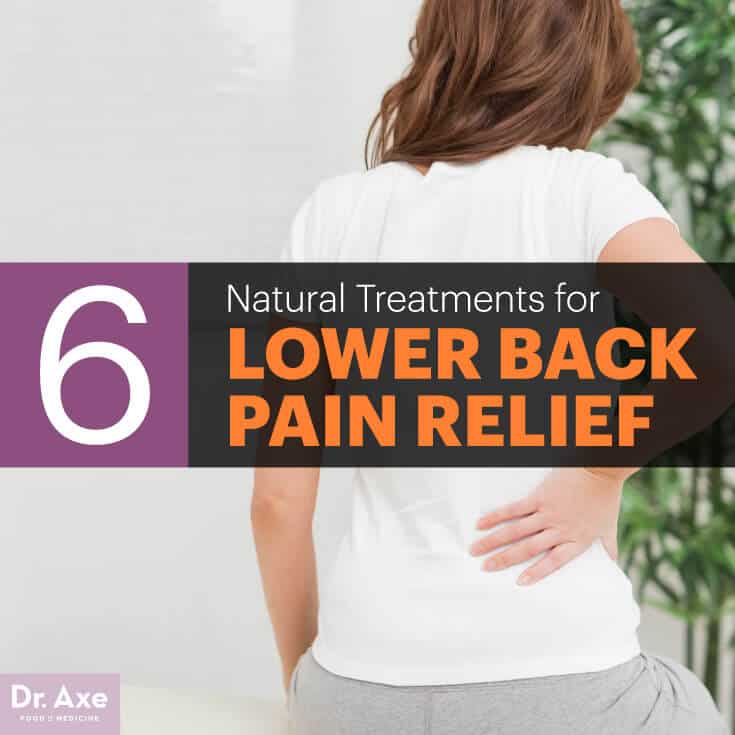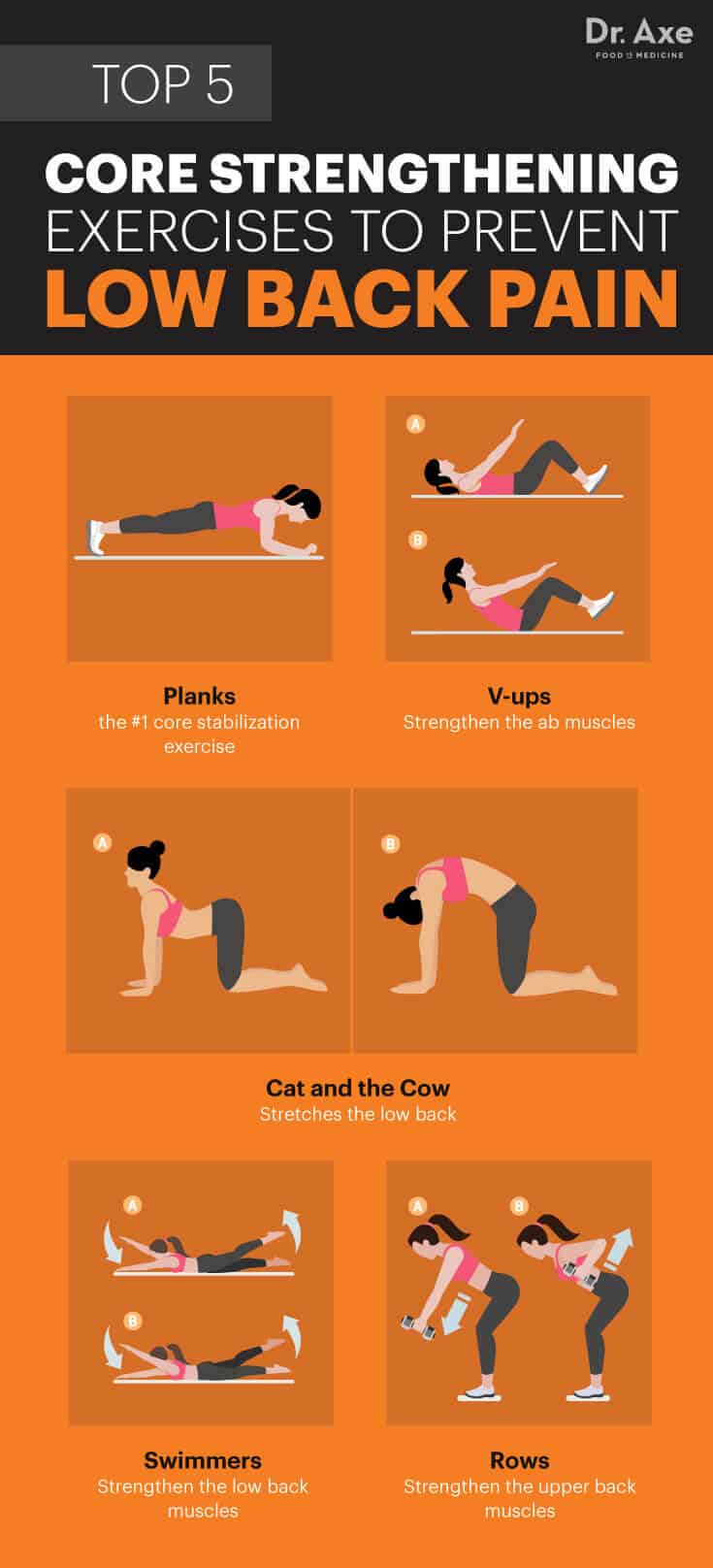
It’s estimated that up to 80 percent of adults experience persistent symptoms of lower back pain at some point in their lives, and about 31 million Americans struggle with the condition at any given time. Given its extremely high prevalence rate — whether due to a weak psoas muscle, sciatic nerve pain or some other cause — it’s not surprising that lower back pain is considered the single leading cause of disability worldwide according to the American Chiropractic Association, with half of all American workers reporting having occasional back troubles each year. (1) Naturally, this leads to millions searching for lower back pain relief.
Lower back pain can be mild to very severe depending on its underlying causes, how long it’s been left untreated and the state of someone’s overall health. The University of Maryland Medical Center states that several important risk factors for lower back problems include family history of back pain, smoking or using tobacco, being overweight or obese, being female, being anxious or depressed, and either doing too much physical work or living a sedentary lifestyle.
One of the most common reasons people develop low back pain is posture. Postural problems, including spinal abnormalities, along with muscular compensations or inactivity put added pressure on the back. Although people of all ages experience low back pain — including both athletes and those who are sedentary — middle-aged to older adults (especially when they’re overweight) are most likely to develop severe symptoms and therefore can benefit from lower back pain relief treatments like chiropractic care, soft tissue therapy and regular exercise.
Natural Treatments for Lower Back Pain Relief
1. Chiropractic Adjustments and Other Postural Treatments
Regular chiropractic care adjustments have proved to be very effective at helping provide lower back pain relief, especially when combined with other treatments like physical therapy (if needed), exercise, massage therapy or soft tissue therapies.
Patient information articles published in both the Journal of North American Spine Society and the Journal of the American Medical Association found evidence that spinal manipulations were safe, effective, drugless forms of professional treatment for both acute (short-term or sudden) and chronic low back problems in adults. (2, 3) Egoscue, another type of postural therapy protocol that focuses on fixing musculoskeletal misalignments, may also be able to help reduce and prevent back pain.
2. Regular Full-Body Exercise
Exercising regularly, including doing both cardio/aerobic exercises and strength training, can help reduce back pain by increasing flexibility, helping you maintain a healthy weight, reducing inflammation, improving posture and reducing muscular compensations/weakness. The top five exercises to strengthen your core to both prevent lower back pain and provide lower back pain relief are planks, cat and the cow, V-ups, swimmers, and rows.
Tips for getting the most lower back pain relief from exercise include:
- gradually starting any new program
- warming up and stretching before beginning a workout
- learning proper posture or form (especially when lifting heavy objects, squatting or climbing)
- wearing supportive sneakers, possibly with insoles if needed
- avoiding sitting too much during the day or periods of prolonged inactivity, such as bed rest, if possible
- giving yourself enough rest between tougher workouts to recover properly
As part of your exercise routine, you may want to consider doing yoga regularly for lower back pain relief. One study of over 960 people with low back pain found that those who completed a 12-week yoga program experienced greater improvements in back function and reduced pain compared to controls who did not participate. (4) There’s even evidence that mindfulness meditation, often practiced in some form with yoga, can also help people deal with chronic back pain more effectively. (5)
3. Soft Tissue Therapy
Soft tissue therapies — including active release technique, Graston technique or massages — may be able to help treat and prevent short- and long-term back problems without the use of drugs (or sometimes combined with medications for stronger effects).
Soft tissue therapies help treat the underlying causes of back pain, such as poor posture, muscular compensations, and weakness through manipulative, hands-on adjustments. These natural therapies can help “turn on” muscles that have been “turned off” due to past injuries and therefore eliminate added stress on painful parts of the back or legs. I recommend finding a practitioner who offers one of the following:

4. Prolotherapy for Chronic Injuries/Tissue Damage
Prolotherapy has been used to treat back pain for more than 50 years, according to a report by the Cochrane Database of Systematic Reviews. (6) Prolotherapy, including the specific type called PRP or dextrose/glucose prolotherapy treatments, use platelet-rich plasma and sometimes stem cells taken from your own body that contain growth factors that help heal damaged tissues.
Prolotherapy treatments work by naturally promoting a minor inflammatory response near damaged connective tissue, promoting regeneration and the growth of new, healthier tissue in the process. These treatments have been used to effectively reduce or heal chronic musculoskeletal conditions of the back, such as herniated/bulging discs, arthritis, osteoarthritis or other chronic joint pains, and tendonitis that affects the lower body and causes compensations in the spine. (7) For the most benefits, it seems that prolotherapy works best when combined with other back pain treatments, such as spinal manipulation, exercise and in some cases medications when needed.
5. An Anti-Inflammatory Diet High in Collagen
If you want to improve overall joint and muscular health, maintain a healthy body weight, lower inflammation, and prevent back pains from returning in the future, consuming a healthy, healing diet is key. Start adjusting your diet by eating more of the following unprocessed, anti-aging, anti-inflammatory foods to help with lower back pain relief:
- High-fiber foods — A high-fiber diet may be able to help you lose weight and overcome problems like high blood pressure, plus it’s beneficial for gut health and digestion. Constipation can make back pain worse, so eat plenty of fruits and vegetables, which are naturally high in fiber and other nutrients.
- Water — Stay hydrated to prevent muscle spasms, manage blood pressure and improve digestion. Drink eight glasses of water daily as dehydration can increase back pain.
- Potassium-rich foods — Potassium reduces swelling and is an important electrolyte for muscular and nerve functions. Include potassium-rich foods (which also tend to be high in beneficial magnesium) in as many of your meals as possible, such as green leafy vegetables, avocados, bananas, coconut water and cultured dairy.
- Omega-3 fats — Wild-caught fish and flaxseed are high in omega-3 fatty acids, which can help reduce inflammation and manage pain.
- Clean, lean protein foods — Choose pasture-raised chicken and turkey or grass-fed lean meats to provide your body with adequate protein needed to maintain muscle and bone health. Other good protein sources include cage-free eggs, fish, bone broth or other unprocessed protein powders, beans, and legumes.
To avoid unwanted weight gain, consuming inflammatory ingredients or complications due to nutrient deficiencies, reduce or eliminate the following foods: added sugar, sweetened beverages or snacks, refined vegetable oils, refined grain products, too much alcohol and tobacco products (smoking impairs blood flow and adds to nutrient deprivation to spinal tissues).
6. Supplements to Reduce Inflammation and Pain
- Fish oil (2,000 milligrams daily): People with back pain need higher doses of omega-3 fats to help reduce inflammation. Supplementation is often required since most of our diets don’t include the necessary dosage.
- Turmeric (1,000 milligrams daily): Turmeric contains curcumin, which is the active ingredient that has powerful anti-inflammatory abilities, anti-aging effects and reduces pain.
- Proteolytic enzymes/bromelain and papain (500 milligrams three times daily): Found in pineapple, these enzymes are natural anti-inflammatories that also help reduce swelling.
- MSM (2,000–8,000 milligrams daily): MSM is an anti-inflammatory supplement that’s high in sulfur to help rebuild cartilage. It can help alleviate muscle spasms.
- Magnesium (400–500 milligrams daily): This mineral is sometimes called the “relaxation mineral” because it helps relax muscles and reduce stress. Decrease the dosage of magnesium if it causes diarrhea.
- Essential oils: Peppermint and wintergreen oil are effective analgesics that cool inflamed joints and reduce back pain. You can mix these oils with coconut oil and rub onto joints or make a homemade muscle rub. Frankincense and cypress oil reduce inflammation and improve circulation, which improves back pain.
- Capsaicin cream: Capsaicin cream (derived from hot chili peppers/cayenne) can be applied to the skin to temporarily reduce chemicals that contribute to inflammation and pain.
Lower Back Pain Causes and Risk Factors
The good news regarding back pain is this: Most cases of lower back pain are believed to be due to “mechanical” problems of the musculoskeletal system rather than serious illness or chronic health problems. Abnormalities, weakness, and added stress placed on the bones, joints, ligaments and muscles can all contribute to back problems. It’s been found that the most common causes of low back pain (there are many!) include: (8)
- Postural problems, including spinal abnormalities, such as ruptured disc, bulging disc or herniated disc. These back problems can cause the spongy, gel-filled cushions that lie between each vertebra to become compressed or fractured.
- Muscular strains and/weakness, or possibly fractures, that cause compensations and added pressure on the back (such as a weak core, tight hamstrings or weak glutes)
- Poor form when exercising
- Overtraining (over-exercising without enough rest between, especially when stretching is overlooked)
- Exercise or sports-related injuries or accidents, including pulls or strains
- Inflexibility and stiffness due to aging
- Wearing non-supportive shoes, especially if standing for long periods every day
- Obesity and a sedentary lifestyle
- Pregnancy
- Emotional/psychological stress
- Lack of sleep, sleeping in an uncomfortable sleep positions or sleeping on a poorly made mattress
- Arthritis and other joint irritation, degeneration or inflammation-related problems
- Osteoporosis (bone loss)
- Constipation, which can add pressure to the abdomen and cause muscle spasms
- Infections of the internal organs (such as kidney stones, kidney infections, blood clots or bone loss) or other chronic conditions that affect the immune system, such as autoimmune disorders or cancer
Facts and Figures About Lower Back Pain
- Both men and women commonly develop back pain, however some research shows women tend to have more recurrent symptoms.
- Overweight adults who don’t exercise and have other health issues (like spinal problems) are at the highest risk for back pains.
- The incidence of low back pain is highest in someone’s 30s, and overall prevalence increases with age until the 60–65 age group, at which point it seems to decline.
- Globally, back pain is one of the most common reasons for missed work days and the second most common reason for doctor office visits. It’s estimated that around 13 million people go to the doctor for chronic back pain every year.
- Approximately 2.4 million Americans are chronically disabled due to back problems. At any given time, around 2.4 million adults are temporarily disabled. (9)
- Studies show that back pain symptoms tend to come back. The rate of recurrence at one year ranges from 24 percent to 80 percent depending on the group. (10)
- Americans spend at least $50 billion each year to help diagnose and treat various lower back pain symptoms.
- Back pain can be both acute (defined as pain that lasts between four and 12 weeks) and chronic (pain that persists for 12 weeks or longer). (11) About 20 percent of people affected by acute low back pain develop chronic low back pain that winds up lasting more than one year.
- The majority of lower back pain cases are caused by irritation/inflammation of five spinal vertebrae (referred to as L1–L5) in the lumbar region, which supports much of the weight of the upper body. Thirty-one pairs of nerves are also rooted to the spinal cord, which can cause radiating pain downward or outward.
Common Signs and Symptoms of Lower Back Pain
Back pain affects everyone differently, which makes sense considering there are so many different reasons it can develop, along with various parts of the back/spine that can be affected. Common signs and symptoms of lower back pain can include: (12)
- Tenderness and pain radiating from the low back downward into the thighs. This is likely to be worse when walking, exercising, standing or moving.
- Stiffness in the lower back and reduced range of motion. In moderate to severe cases, this can stop you from walking, bending, climbing or lifting normally.
- Pain when sleeping or once standing up in the morning.
- Inability to stand up for long periods or worsened pain when you do.
- Discomfort near the tail bone while sitting, especially when sitting for long periods, such as at work or when driving.
- Muscle weakness, heaviness or numbness near the thighs and lower back.
- Sharp pains following a sudden injury, impact, trauma, collision or fall (such as from a sports injury, strain from lifting, car accident or too much twisting or bending).

Conventional Treatment for Lower Back Pain Relief
Today, the most common conventional treatments for lower back pain relief are medications, including NSAIDS like aspirin and Tylenol, along with more potent prescription painkillers, such analgesics. These drugs can potentially cause adverse side effects in some patients and commonly don’t solve the underlying causes of lower back pain (such as poor posture, obesity or exercise-related strains). Some medications for back pains have even been tied to complications, such as liver damage or intestinal bleeding, when taken for long periods of time or in high doses.
After reviewing data regarding various treatments for lower back pain, the Agency for Health Care Research and Quality concluded that those suffering from back pain should first try conservative/natural treatments and then consider other options for lower back pain relief if pain persists. Oftentimes low back pain sufferers can find relief naturally by making changes to their lifestyles (including sleep, physical activity, stress and body weight) before choosing more intensive care options.
Precautions Regarding Lower Back Pain and Lower Back Pain Relief
Although most cases of back pain are “uncomplicated” and should be able to heal with the treatments mentioned above, sometimes in severe cases other interventions are necessary. Speak to your doctor if you experience lower back pain that does not get better in a few days or weeks. If back pain starts suddenly, look out for other symptoms that may point to a more serious condition, such as a fever, chills, dizziness, numbness or unexplained weight loss.
Always visit a doctor or the emergency room following trauma to the spine, especially if the patient is a child or over 70 years old. Mention to your doctor any possible associations with back pain, including autoimmune disease, infections, a history of kidney problems or cancer.
Final Thoughts on Lower Back Pain Relief
- Lower back pain has an extremely high prevalence rate, affecting up to 80 percent of all adults at some point. Causes of back pain include postural problems, spinal abnormalities, poor form when exercising, being overweight, aging or being sedentary.
- Symptoms of back pain usually get worse with movement, lifting or climbing. They commonly include limited range of motion, shooting pains down the back, pain when sleeping or pain when standing for long periods.
- Natural treatments for lower back pain relief include chiropractic adjustments, exercise and/or yoga, a healthy diet high in collagen and soft tissue therapies.

Original article and pictures take draxe.com site
Комментариев нет:
Отправить комментарий